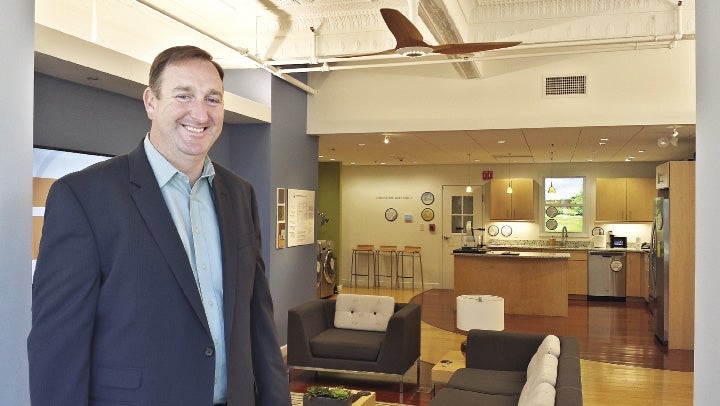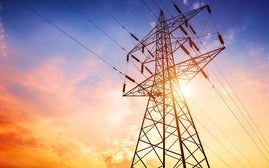Technology powers Worcester's Smart Grid pilot
Outside National Grid's Sustainability Hub on Main Street in Worcester, an electric car charges while a host of energy-efficient appliances inside sit ready to respond to wireless signals to shut them off during times of high energy use. The technology showcased by the 2,200-square-foot center has become a reality for 15,000 National Grid customers in Worcester who are participating in the utility's smart meter pilot program.
The meters, installed throughout the city at businesses, schools and residences as part of a $44 million program, wirelessly transmit a reading of the customer's energy use every five minutes. The data is relayed to the customer through the internet. The meters can also be used to turn off power to appliances during times of peak energy use.
The program has met with resistance from those who feel this additional reporting of information creates the potential for invasions of privacy, as well as health concerns from the added radio waves the meters emit.
Patricia Burke has been active in the community, raising concerns about the amount of data being transmitted, its security and how National Grid will use it. There's also a question of who owns the data it gathers, she said.
“The U.S. is trying to manage the grid on the demand side, and they are not only connecting data, but it is interesting that the market will be able to remotely control their devices,” she said. “It's collecting very fine, granular data about what is happening inside the house.”
But Ed White, National Grid's vice president of customer strategy and environmental, said the utility takes information security seriously and doesn't share data with third parties. The company has been receiving customer information for years, he said, and while data will be received more frequently under the program, the main difference is that it's being applied to how energy is routed to customers while allowing them to view their energy use.
“If a customer wants just a basic meter with basic electricity, that is fine. But we truly believe that as the years go by, more and more will want more information,” White said. “They will feel like they are missing something.”
The health impact — ranging from reports of general sickness to cancer — of smart meters has been raised at city council meetings. Michael Hirsh, Worcester's acting commissioner of public health, informed councilors that research shows the meters are more benign than a cell phone. But Burke questions the cumulative effects of smart meters and doesn't feel health effects have been taken into account in the pilot.
White, meanwhile, said National Grid takes health concerns seriously, but that when it comes to any concerns regarding smart meters, he has to “agree to disagree” when it comes to objections.
He said that despite the protests of some groups, the program has had only a 6-percent “opt out” rate.
Lower rates?
Starting next year, the 15,000 customers can enroll in an electric plan that ties their electricity bills to the real-time market price of power. Energy is more expensive during peak events such as the warmest days of summer, White said. Pricing is reset every six months for residential customers in Massachusetts based on the market price of power, which reflects anticipated demand averaged out for the coming months.
The price of the power National Grid delivers is tied directly to usage. When additional power is needed during peaks, power companies must either call on providers to increase power production or rely on customers to lower consumption. That's the cheaper option.
Those participating in the program will see lower costs except during these peak events, limited by law to 30 days a year. National Grid will use smart meters to cut power during these events to certain “high use” items, such as air conditioners and dishwashers, unless the customer opts out or chooses to turn it on himself. The cut in power saves them money while potentially saving money for every National Grid customer since it eases the load on the system.
Customers will be notified of these events a day ahead, said White, allowing them to prepare for a cut in power.
The biggest long-term change will be how the grid will deliver power in the future. Transmission and distribution losses across the U.S. power grid averaged 6 percent in 2013, according to the International Energy Agency. That's down from 9 percent in 1961, but still lags behind some of the most energy-efficient countries, such as Germany, which only loses 5 percent of its energy in transmission, and Israel, which loses 2 percent. An updated grid would be more efficient, and able to direct power more precisely, National Grid believes.
Smart grids will also be imperative in integrating renewable energy into the grid, according to Charles Agosta, who chairs the physics department at Clark University.
Agosta has been studying smart grids for 10 years. Renewable energy production, from sources such as wind and solar, fluctuates naturally. That's not a huge concern since about 10 percent of the energy comes from renewable resources, he said. But if the grid were to see solar's contribution rise to 30 percent, a few days of cloudy weather could wreak havoc on power delivery without a better grid to deliver it, Agosta said.
“The common way people are using renewable energy is putting them on houses and businesses and at the individual level. No one is thinking about how that power is managed,” he said. “With all this renewable energy on the grid now, the source of energy is not necessarily in sync with the energy needs. At some point, we are going to need a smarter grid.”
White agrees that for a true integration of renewable energy, the grid will need to be improved. While National Grid has been putting renewable energy into the system, the utility has not been able to integrate alternative power so it can be relied upon. This can be done by communicating with alternative energy-generating stations much like the company does with the pilot households.
“As we get to this smarter grid … we are going to be able to know a wind turbine is spinning and has battery power into the future so on that peak day, we can rely on that,” White said.
A full revamp of the grid will take years to make its way incrementally across Massachusetts said White, who explained that a “smartening” of the grid is inevitable. But before that can take place, the pilot program will move forward over the next two years with findings being reported to the state.
“The program is designed to see what customers are going to really like and what is going to be relevant to them and what is not,” said White, who believes some form of smart grid technology will work its way across the state. “It is coming.”















0 Comments